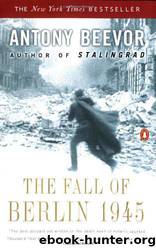The Fall of Berlin 1945 by Antony Beevor

Author:Antony Beevor [Beevor, Antony]
Language: eng
Format: epub, mobi
Tags: Europe, Military, Germany, World War II, History
ISBN: 9780142002803
Google: JSi86mzy64EC
Amazon: 0142002801
Publisher: Penguin
Published: 2003-04-29T04:00:00+00:00
15
Zhukov on the Reitwein Spur
General Chuikov, the commander of the 8th Guards Army, had the best view of the Oderbruch and the Seelow Escarpment from his forward command post on the Reitwein Spur. He was not pleased when Marshal Zhukov decided to join him there to watch the opening bombardment and the attack. Chuikov ordered Captain Merezhko, a staff officer who had been with him since Stalingrad, to go back across the Oder and lead the Front commander and his retinue to the position.
To Chuikov's fury, Zhukov's convoy of vehicles with their headlights on could be seen approaching from a great distance. Chuikov had almost certainly been prejudiced against Zhukov since the winter of 1942. He seems to have felt that the heroic role of his 62nd Army in Stalingrad was overlooked, and too much attention paid to Zhukov. Much more recently, he resented the remarks made about the length of time he had taken to capture the fortress of Poznan. And his own comments about the failure to have pushed straight on to Berlin at the beginning of February had clearly angered Zhukov.
Below them on the Oderbruch, an officer remembered, the trenches were alive with rattling pots. They could all smell the soup being ladled out by cooks to feed the men before the attack. In the forward trenches dug into the cold, sodden earth, troops took sips from their vodka ration. In command posts field telephones rang constantly and runners came and went.
Zhukov arrived, accompanied by a retinue including General Kazakov, his artillery commander, and General Telegin, the head of the Front political department. They were led up a path round the side of the spur and reached the bunker dug by Chuikov's engineers in the side of the small cliff below the observation post. 'The hands of the clock had never gone round so slowly,' Zhukov recorded later. 'To fill the remaining minutes somehow, we decided to drink some hot, strong tea, which had been prepared in the same bunker by a girl soldier. I can remember for some reason that she had a non-Russian name, Margo. We drank the tea in silence, everyone occupied with his own thoughts.' General Kazakov had 8,983 artillery pieces, with up to 270 guns per kilometre on the breakthrough sectors, which meant a field gun every four metres, including 152mm and 203mm howitzers, heavy mortars and regiments of katyusha rocket launchers. The 1st Belorussian Front had a stockpile of over 7 million shells, of which 1,236,000 rounds were fired on the first day. This artillery overkill and the overwhelming superiority of his forces had tempted Zhukov into underestimating the scale of the obstacle facing them.
Zhukov usually insisted on visiting the front line in person to study the terrain before a major offensive, but this time - mainly due to constant pressure from Stalin -- he had relied largely on photo-reconnaissance. This vertical picture failed to reveal that the Seelow Heights, dominating his bridgehead on the Oderbruch, was a far more formidable feature than he had realized.
Download
This site does not store any files on its server. We only index and link to content provided by other sites. Please contact the content providers to delete copyright contents if any and email us, we'll remove relevant links or contents immediately.
| Belgium | France |
| Germany | Great Britain |
| Greenland | Italy |
| Netherlands | Romania |
| Scandinavia |
Room 212 by Kate Stewart(5077)
The Crown by Robert Lacey(4766)
Endurance: Shackleton's Incredible Voyage by Alfred Lansing(4724)
The Iron Duke by The Iron Duke(4325)
The Rape of Nanking by Iris Chang(4173)
Joan of Arc by Mary Gordon(4058)
Killing England by Bill O'Reilly(3974)
Say Nothing by Patrick Radden Keefe(3940)
I'll Give You the Sun by Jandy Nelson(3399)
Shadow of Night by Deborah Harkness(3327)
Hitler's Monsters by Eric Kurlander(3294)
Mary, Queen of Scots, and the Murder of Lord Darnley by Alison Weir(3177)
Blood and Sand by Alex Von Tunzelmann(3170)
Eleanor & Park by Rainbow Rowell(3120)
Darkest Hour by Anthony McCarten(3100)
Margaret Thatcher: The Autobiography by Thatcher Margaret(3053)
Book of Life by Deborah Harkness(2895)
Red Famine: Stalin's War on Ukraine by Anne Applebaum(2895)
The One Memory of Flora Banks by Emily Barr(2836)
